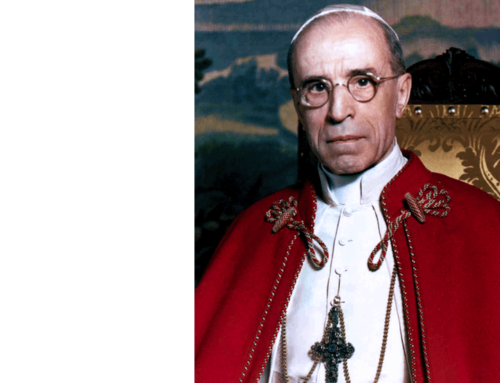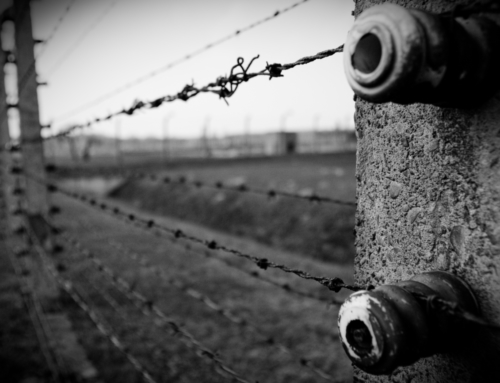| Robert P. Lockwood
Catalyst, May 2001 Over the last two years, there have been a series of books that have dealt both directly and indirectly with the accusation that Pope Pius XII bore responsibility for the Holocaust in World War II. Beginning with John Cornwell’s “Hitler’s Pope,” through Garry Wills’ “Papal Sin” and concluding with James Carroll’s “Constantine’s Sword,” all three books managed a short life on the New York Times’ bestsellers list. These books have been influential in perpetuating the myth that Pope Pius XII was a silent witness to the Holocaust who did virtually nothing to help the Jews. The authors claim that Pius was more interested in maintaining and reinforcing a developing papal absolutism than in facing the Nazis. Each book, of course, has its own particular emphasis in addressing the subject. Cornwell portrays Pius as a monarchial pope with an anti-Semitic background whose primary agenda was increased centralization of power within the Church. While Wills’ disavows any in depth exploration of the papal role in the Holocaust, his analysis of Pius and the Church during World war II serves to introduce his central thesis that the Church has in place “structures of deceit” created to artificially prop-up papal power. Carroll relies primarily on Cornwell as his source for the role of Pius in the Holocaust. He echoes Cornwell’s theory of Pius as solely concerned with papal power, but also sees Pius’ alleged lack of action in the face of the Holocaust as historically determined by 2,000 years of Church anti-Semitism. The critical aspect of all three books is that the authors identify themselves as Catholic, and have a different agenda in mind than condemning Pope Pius XII. Pius and the Holocaust, even in Cornwell’s account, are only tools for the premise that underlies all three books: that the papacy itself is the primary target, both in general, and specifically the papacy of Pope John Paul II. All three books use Pius XII, and exploit the Holocaust, as a means to make points in an internal Catholic debate over papal primacy – meaning the extent of papal juridical authority within the Church – and papal infallibility. To see any of these books as a serious investigation into Catholic-Jewish relations, and how the Church under Pius responded to the Holocaust, is to misunderstand their purpose. For the 13 years after World War II ended until his death on October 9, 1958, Pius XII was universally acclaimed for his efforts to save Jewish lives in the face of the Holocaust. There were no accusations during this period of a “silent” pontiff with pro-Nazi leanings. Yet, five years after his death, the reputation of Pius was beginning to face serious historical revisionism. Why this revisionism? Pius XII was unpopular with certain circles for the anti-Stalinist, anti-Communist agenda of his post-war pontificate. In leftist academic circles, particularly in Italy in the late 1950s and throughout the 1960s, Pope Pius was seen as the standard-bearer for a political crusade, establishing the Church as a universal anti-Communist force. There was a concerted effort to discredit both that crusade, and the pontificate that was perceived as generating it. The animus against Pius by some Catholics was certainly influenced by this agenda, but was not overly strong during the papacies of Pope John XXIII and Pope Paul VI. It would not be until the papacy of Pope John Paul II that a stronger reaction began to develop against Pius within certain Catholic circles. As is clearly seen in Cornwell’s book, that response against Pope Pius XII generally developed out of a reaction against the papacy of Pope John Paul II. Under Pope John Paul II, Cornwell charges, “Pacelli’s monolithic pyramidal model of the Church has once again reasserted itself.” Cornwell’s essential theory is echoed in both Wills and Carroll. “So what accounts not only for the silence of Pope Pius XII, but for Eugenio Pacelli’s complicity with Hitler in the early years?” Carroll asks, assuming both that alleged silence and alleged complicity. “The early years offer the clue, for it was then that Pacelli’s determination to put the accumulation and defense of papal power above everything else showed itself for what it was.” Wills portrays Pius as perhaps an unwitting victim of “structures of deceit” that force people to lie to defend papal authority. Pope Pius XII did what he had to do in the war, according to Wills, to maintain these structures of deceit that support papal power. All three books reference their views on Pope Pius XII both forward to Pope John Pail II and back to Pope Pius IX and the First Vatican Council (1869-1870). That Council’s definition of papal infallibility is seen as the foundation of Pius’ alleged obsession with a monarchial papacy, and Pope John Paul II’s exercise of papal authority. The essential argument is that the First Vatican Council of the 19th Century fundamentally changed the Church by creating out of whole cloth a doctrine of papal infallibility and that this doctrine greatly enhanced a centralization of juridical power within the Church under the papacy. It was the machinations of Pope Pius IX, resenting the end of the temporal power of the papacy, which caused this allegedly revolutionary development. The argument continues that Pope Pius XII was raised in the Church in an atmosphere where this new papal power was being codified and confirmed. As Secretary of State under Pope Pius XI, and as pope, this papal autocracy would be the driving force behind every decision and policy, including Church reaction to Nazism and the Holocaust. The narrative continues that after Pius died, the Second Vatican Council was called by Pope John XXIII to limit this papal autocracy. But the Council is undermined by his successor, Paul VI, who was trained under Pope Pius XII. Pope John Paul II is then portrayed as engaged in a complete dismantling of the reforms the Second Vatican Council. All of which is a simplistic reading of history tied to a fixation on the papacy and alleged papal power, as well as a ridiculous charge against Pope John Paul II. In regard to the First Vatican Council, virtually no one in the hierarchy of the Church outright rejected the theological concept of papal infallibility – that when the Pope formally addressed matters of faith and morals as the Vicar of Christ, he was guided by the Holy Spirit and therefore not subject to error. However, the extent of that infallibility had never been clearly defined and that is where true divisions existed. Examples were papal encyclicals were they infallible papal statements, true for all times and for all people? Was every public statement of the pope to be considered infallible? Some certainly believed so. Others, however, did not believe that understanding was within Catholic tradition. That the First Vatican Council was manhandled by Pope Pius IX and the Curia to force a definition of papal infallibility not in keeping with Catholic tradition is a historical invention. In fact, the debate over the definition of papal infallibility went on for months. Consensus emerged which spelled out a definition of papal infallibility clearly in line with Church tradition and the theology of the papacy. The Council proclaimed no new teaching that extended papal authority beyond a point understood for centuries. Subsequent popes have issued one ex cathedra infallible statement (Pope Pius XII defining Catholic teaching on the Assumption of Mary in 1950) and did so only after extensive consultation with the world’s bishops. Wills and Cornwell then focus on the area of episcopal appointments, seeing this as a critical area in the late 19th and early 20th Century where papal juridical “control” of the local Church expanded enormously. Both see this as a nefarious plot to extend papal power. While Wills argues this point, and Cornwell sees Pacelli as the agent provocateur for amassing papal power even in the face of the Holocaust, both are reading evil into a centuries-long reform movement to free the church from local control, the single most critical cause of hierarchical and Church scandal throughout history. It is true that the movement to secure the appointment of bishops exclusively through the Holy See accelerated over the last quarter of the 19th and early 20th century. But the historical reasons for this are hardly sinister plots engineered at Vatican I. The governments of Europe that, to varying degrees, still had power over the appointments of bishops had become aggressively secular. (The Austrian monarchy retained veto power over the election of popes in the early 20th century.) Securing the right to manage its own affairs, including the appointment of bishops, was far from creeping papal absolutism. It was, in fact, liberating the Church from State domination. In our own day, this is still very much an issue, particularly in China, where the Chinese government refuses the right of the Vatican to appoint bishops and has set-up its own “Patriotic National Church.” Carroll’s book neatly sums-up the similar agenda of all three authors in his call for a Vatican III. Carroll argues that a Third Vatican Council is necessary because, reflecting Wills and Cornwell, the Second Vatican Council, a historic beginning, was undermined by Pope Paul VI, a “devoted factotum to Pius XII.” Pope Paul VI turned back the reforming trend of the Second Vatican Council, in a “program of medieval restoration” that “has been vigorously continued by Pope John Paul II.” Carroll’s Third Vatican Council would abandon the “primary-enforcing ideas of Roman supremacy and papal infallibility.” Freed from the papacy, the Church will embrace the democratic ideal and abandon “the idea that there is one objective and absolute truth, and that its custodian is the Church.” Bishops should be chosen by the people, the whole clerical caste eradicated, and women ordained (though ordination to exactly what is never clarified) under Carroll’s agenda. This anti-papal trilogy of books is not a serious exploration of the Holocaust or of the role of Pius XII during the war years. These are books focused on internal Church disputes over theology and the juridical authority of the papacy. They are merely exploiting the Holocaust – without seriously reflecting on what Pius was able to accomplish – to argue Church politics and theology in the age of Pope John Paul II. Their enemy is actually not Pius XII, but the papacy.
|
| Copyright © 1997-2011 by Catholic League for Religious and Civil Rights. *Material from this website may be reprinted and disseminated with accompanying attribution. |



